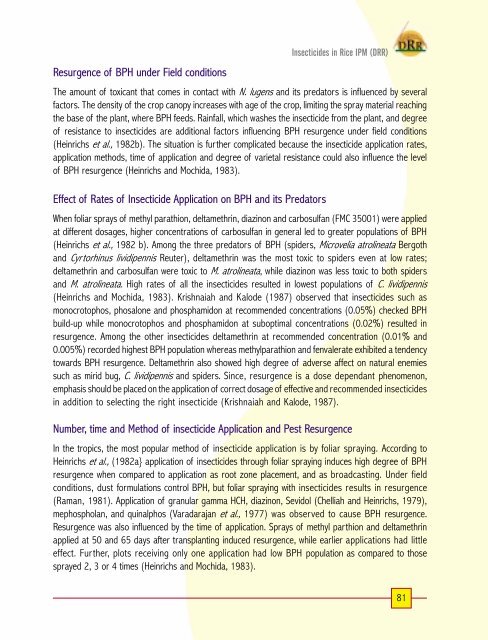priciples of insecticide use in rice ipm
priciples of insecticide use in rice ipm
priciples of insecticide use in rice ipm
Create successful ePaper yourself
Turn your PDF publications into a flip-book with our unique Google optimized e-Paper software.
Resurgence <strong>of</strong> BPH under Field conditions<br />
Insecticides <strong>in</strong> Rice IPM (DRR)<br />
The amount <strong>of</strong> toxicant that comes <strong>in</strong> contact with N. lugens and its predators is <strong>in</strong>fluenced by several<br />
factors. The density <strong>of</strong> the crop canopy <strong>in</strong>creases with age <strong>of</strong> the crop, limit<strong>in</strong>g the spray material reach<strong>in</strong>g<br />
the base <strong>of</strong> the plant, where BPH feeds. Ra<strong>in</strong>fall, which washes the <strong><strong>in</strong>secticide</strong> from the plant, and degree<br />
<strong>of</strong> resistance to <strong><strong>in</strong>secticide</strong>s are additional factors <strong>in</strong>fluenc<strong>in</strong>g BPH resurgence under field conditions<br />
(He<strong>in</strong>richs et al., 1982b). The situation is further complicated beca<strong>use</strong> the <strong><strong>in</strong>secticide</strong> application rates,<br />
application methods, time <strong>of</strong> application and degree <strong>of</strong> varietal resistance could also <strong>in</strong>fluence the level<br />
<strong>of</strong> BPH resurgence (He<strong>in</strong>richs and Mochida, 1983).<br />
Effect <strong>of</strong> Rates <strong>of</strong> Insecticide Application on BPH and its Predators<br />
When foliar sprays <strong>of</strong> methyl parathion, deltamethr<strong>in</strong>, diaz<strong>in</strong>on and carbosulfan (FMC 35001) were applied<br />
at different dosages, higher concentrations <strong>of</strong> carbosulfan <strong>in</strong> general led to greater populations <strong>of</strong> BPH<br />
(He<strong>in</strong>richs et al., 1982 b). Among the three predators <strong>of</strong> BPH (spiders, Microvelia atrol<strong>in</strong>eata Bergoth<br />
and Cyrtorh<strong>in</strong>us lividipennis Reuter), deltamethr<strong>in</strong> was the most toxic to spiders even at low rates;<br />
deltamethr<strong>in</strong> and carbosulfan were toxic to M. atrol<strong>in</strong>eata, while diaz<strong>in</strong>on was less toxic to both spiders<br />
and M. atrol<strong>in</strong>eata. High rates <strong>of</strong> all the <strong><strong>in</strong>secticide</strong>s resulted <strong>in</strong> lowest populations <strong>of</strong> C. lividipennis<br />
(He<strong>in</strong>richs and Mochida, 1983). Krishnaiah and Kalode (1987) observed that <strong><strong>in</strong>secticide</strong>s such as<br />
monocrotophos, phosalone and phosphamidon at recommended concentrations (0.05%) checked BPH<br />
build-up while monocrotophos and phosphamidon at suboptimal concentrations (0.02%) resulted <strong>in</strong><br />
resurgence. Among the other <strong><strong>in</strong>secticide</strong>s deltamethr<strong>in</strong> at recommended concentration (0.01% and<br />
0.005%) recorded highest BPH population whereas methylparathion and fenvalerate exhibited a tendency<br />
towards BPH resurgence. Deltamethr<strong>in</strong> also showed high degree <strong>of</strong> adverse affect on natural enemies<br />
such as mirid bug, C. lividipennis and spiders. S<strong>in</strong>ce, resurgence is a dose dependant phenomenon,<br />
emphasis should be placed on the application <strong>of</strong> correct dosage <strong>of</strong> effective and recommended <strong><strong>in</strong>secticide</strong>s<br />
<strong>in</strong> addition to select<strong>in</strong>g the right <strong><strong>in</strong>secticide</strong> (Krishnaiah and Kalode, 1987).<br />
Number, time and Method <strong>of</strong> <strong><strong>in</strong>secticide</strong> Application and Pest Resurgence<br />
In the tropics, the most popular method <strong>of</strong> <strong><strong>in</strong>secticide</strong> application is by foliar spray<strong>in</strong>g. Accord<strong>in</strong>g to<br />
He<strong>in</strong>richs et al., (1982a} application <strong>of</strong> <strong><strong>in</strong>secticide</strong>s through foliar spray<strong>in</strong>g <strong>in</strong>duces high degree <strong>of</strong> BPH<br />
resurgence when compared to application as root zone placement, and as broadcast<strong>in</strong>g. Under field<br />
conditions, dust formulations control BPH, but foliar spray<strong>in</strong>g with <strong><strong>in</strong>secticide</strong>s results <strong>in</strong> resurgence<br />
(Raman, 1981). Application <strong>of</strong> granular gamma HCH, diaz<strong>in</strong>on, Sevidol (Chelliah and He<strong>in</strong>richs, 1979),<br />
mephospholan, and qu<strong>in</strong>alphos (Varadarajan et al., 1977) was observed to ca<strong>use</strong> BPH resurgence.<br />
Resurgence was also <strong>in</strong>fluenced by the time <strong>of</strong> application. Sprays <strong>of</strong> methyl parthion and deltamethr<strong>in</strong><br />
applied at 50 and 65 days after transplant<strong>in</strong>g <strong>in</strong>duced resurgence, while earlier applications had little<br />
effect. Further, plots receiv<strong>in</strong>g only one application had low BPH population as compared to those<br />
sprayed 2, 3 or 4 times (He<strong>in</strong>richs and Mochida, 1983).<br />
81











